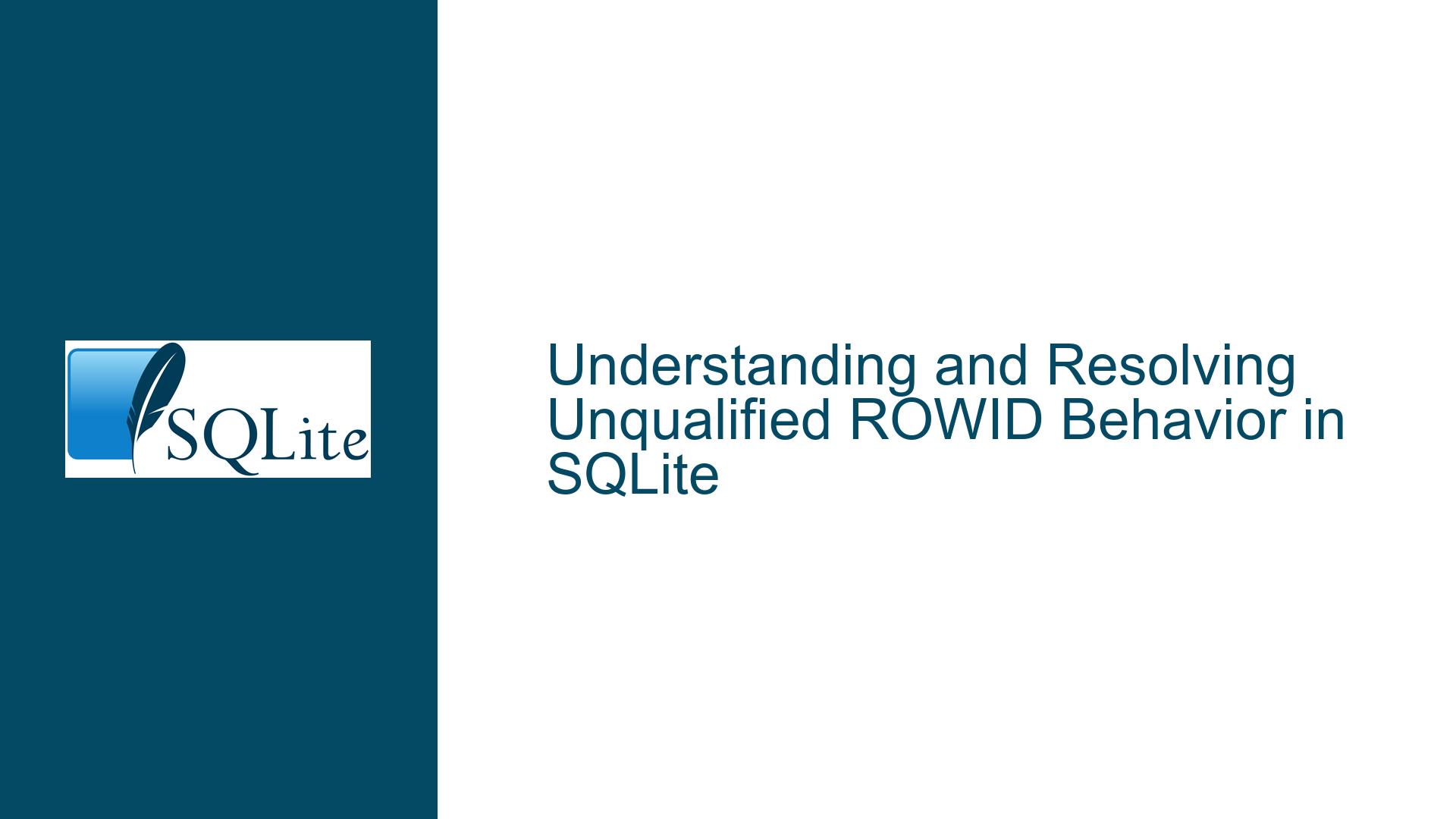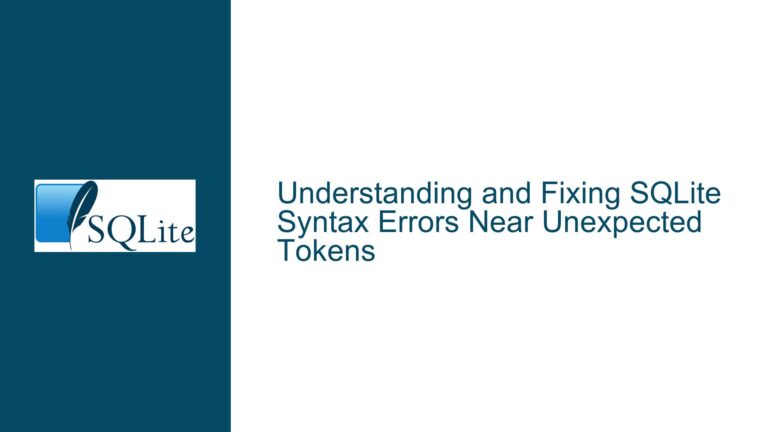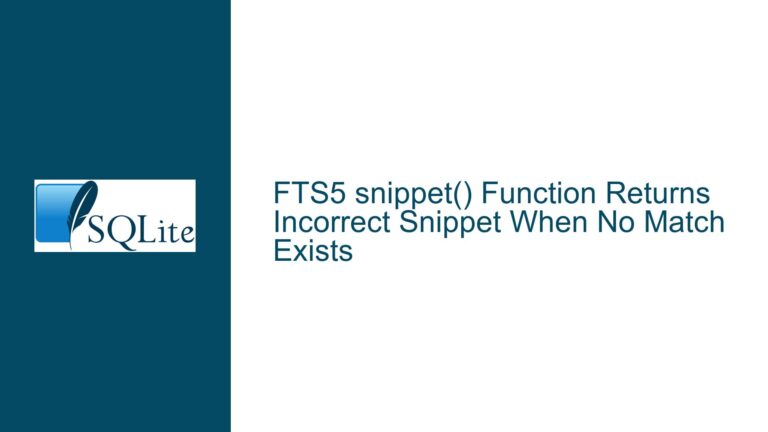and Resolving Unqualified ROWID Behavior in SQLite
Issue Overview: Unqualified ROWID Behavior in SELECT Statements and Views
The core issue revolves around the behavior of the ROWID column in SQLite when used in SELECT statements and views, particularly when the ROWID is unqualified (i.e., not explicitly tied to a specific table). SQLite’s ROWID is a special column that exists in most tables, providing a unique identifier for each row. However, its behavior can become ambiguous or unexpected in certain contexts, especially when dealing with joins, views, or tables created with the WITHOUT ROWID clause.
The problem manifests in several scenarios:
- When selecting
ROWIDfrom a single table, the behavior is straightforward and well-documented. - When selecting
ROWIDfrom a view, the behavior depends on whether the underlying table(s) have an explicitROWIDcolumn. - When selecting
ROWIDfrom a join of multiple tables, the behavior can be ambiguous, leading to unexpected results or errors. - When using tables created with the
WITHOUT ROWIDclause, theROWIDcolumn does not exist, leading to errors when attempting to select it.
The ambiguity arises because SQLite must decide which table’s ROWID to return when the ROWID is unqualified. This decision is influenced by the presence or absence of explicit ROWID columns, the structure of views, and the version of SQLite being used. Additionally, the behavior has evolved over time, with newer versions of SQLite introducing stricter rules to avoid ambiguity.
Possible Causes: Ambiguity in ROWID Resolution and View Handling
The root cause of the issue lies in how SQLite resolves unqualified ROWID references in different contexts. Here are the key factors contributing to the problem:
Ambiguity in Joins: When selecting
ROWIDfrom a join of multiple tables, SQLite must determine which table’sROWIDto return. If multiple tables have aROWIDcolumn, the behavior can be unpredictable. For example, in the querySELECT rowid FROM a,b;, SQLite returnsa.rowidbecause it is the first table in the join. However, this behavior is not explicitly documented and can lead to confusion.Views and Implicit ROWID Columns: Views in SQLite are virtual tables that are defined by a
SELECTstatement. When selectingROWIDfrom a view, SQLite checks whether the underlyingSELECTstatement produces a column namedROWID. If the view’s definition includes a table with an explicitROWIDcolumn, the querySELECT rowid FROM myview;works as expected. However, if the view’s definition does not include aROWIDcolumn, the query returnsNULLinstead of raising an error. This behavior can be surprising and is not well-documented.WITHOUT ROWID Tables: Tables created with the
WITHOUT ROWIDclause do not have aROWIDcolumn. Attempting to selectROWIDfrom such a table results in an error. However, if such a table is included in a join or view, the behavior can be inconsistent. For example, the querySELECT rowid FROM b,d;fails because tabledis aWITHOUT ROWIDtable, even though tablebhas aROWIDcolumn.Version-Specific Behavior: The behavior of unqualified
ROWIDreferences has changed over time. Starting with SQLite version 3.36.0, selectingROWIDfrom a view that does not include aROWIDcolumn results in an error. This change was introduced to avoid ambiguity and improve consistency. However, it can break legacy code that relies on the previous behavior. The-DSQLITE_ALLOW_ROWID_IN_VIEWcompile-time option is provided for such cases.Implicit vs. Explicit ROWID Columns: SQLite treats implicit and explicit
ROWIDcolumns differently. An implicitROWIDcolumn is automatically created for most tables, while an explicitROWIDcolumn is defined by the user. When selectingROWIDfrom a view, SQLite only considers explicitROWIDcolumns. This distinction can lead to unexpected results when working with views.
Troubleshooting Steps, Solutions & Fixes: Resolving ROWID Ambiguity and Ensuring Consistent Behavior
To address the issues related to unqualified ROWID behavior in SQLite, follow these troubleshooting steps and solutions:
Qualify ROWID References in Joins: To avoid ambiguity when selecting
ROWIDfrom a join of multiple tables, always qualify theROWIDreference with the table name. For example, instead ofSELECT rowid FROM a,b;, useSELECT a.rowid FROM a,b;. This ensures that SQLite returns theROWIDfrom the intended table.Explicitly Define ROWID Columns in Views: When creating views, explicitly include the
ROWIDcolumn if it is needed. For example, instead ofCREATE VIEW bv AS SELECT * FROM b;, useCREATE VIEW bv AS SELECT rowid, * FROM b;. This ensures that the view includes theROWIDcolumn, making queries likeSELECT rowid FROM bv;work as expected.Avoid Using WITHOUT ROWID Tables in Joins: If a table is created with the
WITHOUT ROWIDclause, avoid including it in joins or views where theROWIDcolumn is needed. If you must include such a table, ensure that the query does not reference theROWIDcolumn.Upgrade to SQLite 3.36.0 or Later: If you are using an older version of SQLite, consider upgrading to version 3.36.0 or later. This version introduces stricter rules for handling unqualified
ROWIDreferences in views, reducing ambiguity and improving consistency. However, be aware that this change may break legacy code that relies on the previous behavior.Use the -DSQLITE_ALLOW_ROWID_IN_VIEW Compile-Time Option: If you have legacy code that relies on the previous behavior of unqualified
ROWIDreferences in views, you can use the-DSQLITE_ALLOW_ROWID_IN_VIEWcompile-time option when building SQLite. This option restores the previous behavior, allowing unqualifiedROWIDreferences in views to returnNULLinstead of raising an error.Test Views for ROWID Compatibility: Before using a view in production, test it to ensure that it behaves as expected when selecting the
ROWIDcolumn. For example, run the querySELECT rowid FROM myview;and verify that it returns the correct results. If the view does not include aROWIDcolumn, consider modifying the view’s definition to include one.Document ROWID Behavior in Your Codebase: To avoid confusion and ensure consistency, document the behavior of
ROWIDin your codebase. Include information about howROWIDis handled in joins, views, andWITHOUT ROWIDtables. This documentation will help other developers understand and work withROWIDcorrectly.Consider Using Alternative Unique Identifiers: If the ambiguity of
ROWIDis causing issues in your application, consider using alternative unique identifiers, such as an explicitINTEGER PRIMARY KEYcolumn. This approach provides more control and avoids the pitfalls associated with unqualifiedROWIDreferences.
By following these steps, you can resolve the issues related to unqualified ROWID behavior in SQLite and ensure that your queries and views work as expected. Understanding the nuances of ROWID handling is key to writing robust and maintainable SQLite code.






